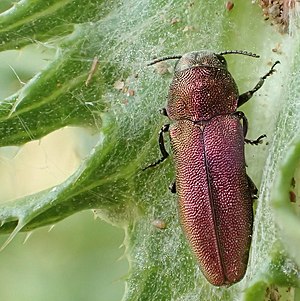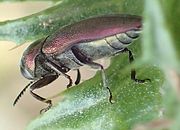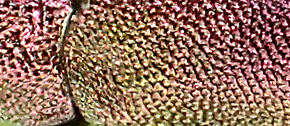Meliboeus episcopalis
| Meliboeus episcopalis | ||||||||||||
|---|---|---|---|---|---|---|---|---|---|---|---|---|

Meliboeus episcopalis |
||||||||||||
| Systematics | ||||||||||||
|
||||||||||||
| Scientific name | ||||||||||||
| Meliboeus episcopalis | ||||||||||||
| ( Mannerheim , 1837) |
Meliboeus episcopalis is a beetle from the family of the jewel beetle and the subfamily Agrilinae . The genus Meliboeus is represented in Europe with nineteen species , which are divided into three subgenera. Meliboeus episcopalis belongs to the subgenus Meliboeus . The unusually colored beetle is only found in southern and eastern Europe.
Comment on the name
The beetle was first described by Mannerheim in 1837 under the name Agrilus episcopalis . Mannerheim takes over the name that Dejean had already given the Beetle in the catalog for his collection. The part of the name episcopālis ( Latin for 'episcopal') most likely refers to the color that rarely occurs in beetles, which is reproduced in the description as supra rubro-aureus (Latin for 'upper side red gold') and is reminiscent of cardinal red .
The species was temporarily placed in the genus Coraebus .
The genus Meliboeus was established by Deyrolle in 1864 when he processed the jewel beetle material collected by Wallace on the islands of the Malay Archipelago . Meliboeus (or Meliboia ) as well as Coraebus are names anchored in Greek mythology that have no relation to the properties of the beetle. Deyrolle gives three types for the genus Meliboeus , one of which is Meliboeus episcopalis .
Since the beetle can also appear differently colored, the color variants have been described more often as separate species. Obenberger differentiates between the varieties gemmeus (described by Abeille de Perrin , brown to coppery), saginatus (described by Kiesenwetter , emerald green) and coelestis (described by Obenberger himself, blue) according to the color of the upper side . The purple variant was also described as Coraebus purpureus (Fig. 1).
Properties of the beetle

|

|
| Fig. 1: Printed by Gory in 1841 |
Fig. 2: Side view from behind - below |

|
|
| Fig. 3: Punctures on the pronotum and elytra | |
The beetle, six to eight millimeters in size, is elongated and almost cylindrical except for the rear area of the wing covers. The whole top is dotted with rather coarse wrinkles . This creates the impression of scales (Fig. 3). The different coloring of the top and bottom is striking. Normally, the upper side is shimmering metallic purple-red, the underside pale greenish and finely haired gray-yellow (Fig. 2). However, the upper side can also be shiny gold, greenish, blue and in rare cases dark green, in which case the purple color is pushed back to the edges.
The head is oriented downwards perpendicular to the body axis. It is strongly arched, the forehead slightly indented. The upper lip is fused with the head skeleton. The deflection points of the antennae are deep and medium-sized. The antennae are barely as long as the pronotum , glossy black, and serrated from the fifth link. The moderately arched, oval eyes lie to the side and are very far apart at the back. Their distance from the pronotum is small.
The pronotum is arched. It is wider than it is long and trimmed at the front. The base is indented on each side, cut straight in the middle. The almost right-angled, truncated rear angles are raised to give space for the knees of the front legs. In contrast to the genus Coraebus , the side margin is not serrated.
The front chest has a strongly pointed extension towards the rear, it is enlarged towards the front with a broad extension (chin band). The chin band is deep in the middle and cut out roughly at right angles and thus divided into two lobes. In contrast to other species of the genus, no longitudinal cavities into which the feelers could be inserted are formed in the sides of the first breast section.
The label is pointed triangular, in contrast to the genus Agrilus it has no transverse keel.
The elytra are together in front about as wide as the pronotum. They have poorly developed shoulders and are indented between the shoulders and the seam, sloping back and outwards. Their sides run almost parallel at the front, in the last third they narrow in a straight line and at the end they are individually rounded. The elytra are pubescent hairy. The wing cover seam is raised like a keel in the rear two thirds.
The legs are moderately robust. The black, five-limbed tarsi are short, the first four limbs about the same length, the claw limb very long (recognizable in the taxo picture). The claws are fused together at the base.
The abdomen is rounded at the back.
biology
The beetle is found in open shrub communities on flowering plants, mainly on thistles of the genus Cirsium . The development is annual and takes place in stems of Cirsium . The species is reported from Greece from mid-April to mid-July.
distribution
The beetle is a pontomediterranean common. It occurs in Europe in Italy and Sicily , in Croatia , North Macedonia , Hungary , Bulgaria , Greece , the European part of Turkey , the Cyclades , the North Aegean Islands , the Dodecanese and Crete . Outside Europe, the species is found in the Middle East and North Africa .
Individual evidence
- ↑ a b Meliboeus episcopalis , and Meliboeus from Fauna Europaea, accessed on February 4, 2019
- ↑ a b Mannerheim: Enumération des Buprestides, et déscription de quelques nouvelles éspèces .... in Bulletin de la Société Impériale des Naturalistes de Moscou tome 10, No. 8, Moscow 1837 p. 107 No. 5 Agrilus episcopalis
- ^ Dejean: Catalog de la Collection de Coléoptères de M. Le Baron Dejean Paris 1837 p. 93 Agrilus episcopalis Dej. in Google Book Search
- ^ Henri Deyrolle: Buprestides de la Malaisie Brussels, Paris 1864 p. 132 Meliboeus
- ↑ E. Abeille de Perrin: Notes sur les Buprestides paléarctiques . In Révue d'Entomologie Volume XV, Caen 1896 p. 269 ff p. 281 Coraebus gemmeus within No. 12 Coraebus episcopalis
- ↑ a b H. v. Kiesenwetter: Natural history of the insects of Germany 1. Section IV. Volume, Berlin 1857 p. 115 No. 6 Coraebus episcopalis , No. 7 saginatus
- ↑ a b J. Obenberger: Studies on Palearctic Buprestids . In Wiener Entomologische Zeitung Volume 35 Vienna, 1916 p. 235ff p. 265 No. 43, variants of Meliboeus episcopalis
- ↑ a b H. Gory: Histoire Naturelle et Iconographie des insectes coléoptères Suite aux Buprestides tome II Paris 1841 Coraebus purpureus and, in the atlas, Plate 3 Fig. 18
- ↑ HC Küster: The Beetles of Europe - described from nature, 3rd issue. Nuremberg 1845 unpaginated, Coraebus purpureus
- ↑ Meliboeus at coleo-net , accessed on February 10, 2019
- ↑ H.Mühle, P. Brandl, M. Niehuis: Catalogus Faunae Graeciae; Coleoptera: Buprestidae Printed in Germany by Georg Rößle Augsburg 2000